Sweat with Kayla – the unstoppable growth of the Virtual Trainer

Who is Kayla and why does everyone want to “do Kayla”?
Ask any of the girls in your section if they do Kayla, I bet you will get at least one “yes”. A resounding “yes” indeed. In fact, they are on their way to a Kayla workout with 5 other girls in the section and want to know if you want to come along. It’s 28 minutes, you do it with your friends (so no social fomo) and you’re done with your workout for the day!
“Sweat with Kayla” refers to the mobile phone app created by Kayla Itsines, a 25 year-old Australian personal trainer and her boyfriend and business partner Tobi Pearce. Through the app, you can access a workout program consisting of 3 strength, 4 cardio, 2 recovery, and a bonus challenge workout accompanied by video demonstration, a countdown clock, and a cool-down routine. The app also features a meal plan, an exercise planner, progress picture (before-after) library and an education session. Basically everything you will ever need from a personal trainer and nutritionist, for $20 a month. The program is also available in pdf form, for $60 if you purchase from kaylaitsines.com.
I believe that Sweat with Kayla is a breakthrough product in its ability to deliver an experience comparable to personal training through brilliant interface design, social enforcing mechanism and scalable business model.
How is Kayla Itsines #winning #squadgoal?
A. Software design solving problems that individuals traditionally “hired” a personal trainer to do
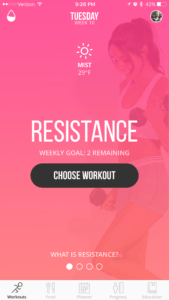



The app “Sweat with Kayla” is pleasant to look at. No matter what screen you are on, you’re looking at a display pared down to the absolute necessary for what the screen is supposed to do.But it does not stop at being a pretty app. It solves the problem of “coordinating” timing, equipment and instructions that individuals face when exercising by themselves. The screen below demonstrates what the circuit is for the week’s arm workout, what equipment you will need, the playlist available (through Apple Music). During the workout, the video demonstration is accompanied by a highly visible countdown clock with accessible “Next” and “Pause” buttons. Those who don’t have the good habit of stretching, fear not, as the app will walk you through a cool down routine for the muscle group of the day right after the workout.
In summary, coordinating and enforcing disciplines are the two critical pain points that individuals traditionally have hired personal trainers to do, now accomplished through user-centered design.
B. Clever uses of social media keeping subscribers hooked
Contributing to Kayla Itsines’ viral success is the built-in social element of the workout. As you are about to start a workout, the app shows words of encouragement from other app users. After each workout, users are prompted to encourage others and take a “selfie” and post on social media to show that you’ve done the workout of the day. These social features create (positive) peer pressure and accountability, “nudging” users into adopting the habit, and hence, happily keep their $20/month subscription.
And finally, the “before – after” pictures are powerful marketing vehicles for Kayla’s program. Kayla stated that she doesn’t believe on the numbers on the scale, and instead choose to encourage her users to post pictures of themselves before and after adopting her program. Her Instagram has 5,000 pictures, many of them are “before – after”, broadcast everyday the potential results of the program to 6.3 million subscribers. Using social media, she keeps her subscribers hooked with the visualization of what they may achieve if they stick with her program.
C. Scalable business model
Last but not least, the software-as-a-service model, delivered through the app store, creates significant scale for Kayla at zero marginal cost per user while in-advance subscription payment reduces her funding needs (minimal to begin with as her product is low-tech). One may say that Kayla is leaving money on the table by making the program available in PDF that could be copied. I see the PDF as the “teaser” and a channel to acquire customers for the app as the PDF fundamentally does not solve the “coordinating”, enforcing disciplines and provide the social elements that the app does. All those activities could be accomplished outside the app, but significantly more inconveniently.
Conclusion
While I am a happy subscriber, I see several challenges for Kayla’s sustainability. One, fitness, like dieting, has proven to be a fad-driven industry where people constantly look for new solutions to age-old problems. How would Kayla sustain her appeal in the possible emergence of, say, virtual reality social workouts? Second, her workout program is bounded in 12 weeks and though her workouts do vary and increase in difficulty, what would she do to keep it fresh and her users challenged? Third, there is virtually no barrier to entry for other app designers/trainers to come in with their own workout app. Unsubscribing and downloading new apps are what most mobile users do daily.My opinion is this is the type of business you want to “milk” as much as you can while you still can. And it appears that she is doing just that.






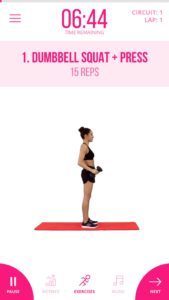
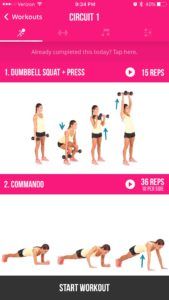
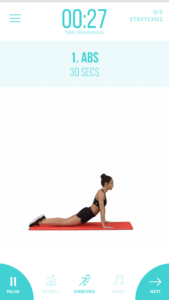
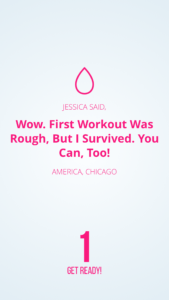
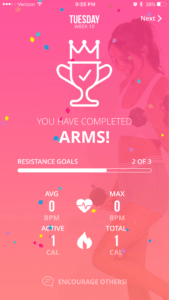
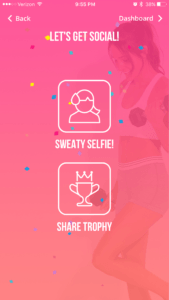
Great post — I didn’t realize how “Sweat with Kayla” was such a built-out brand and business. Agreed re: your point on sustainability. I have to wonder whether more ‘newer + younger’ fitness gurus will pop up after seeing how lucrative this business is. Eg, One company that’s popped up recently is Forte, which is a blend of Netflix + ClassPass– I’m interested to see how they do in the market and how this affects companies like ‘Sweat with Kayla.’
I heard about Kayla but never looked into the app. It’s definitely a new way of thinking about a solid workout. The community aspect is interesting, as many people enjoy boutique fitness classes because of the community so that may be one way to attract class goers. There are countless fitness app out there that promise to do the same (Kayla’s UI is much better though) but I guess the biggest challenge here is convincing people that this is an effective workout, and Kayla use of social media and before and after photos is a great way of doing that! I just downloaded the app and started my 7 day trial, excited to try it out.
Thanks for the post! I have done the Kayla Itsines workout using the PDF, and had not seen the app before. While the workout has been all the rage for the past few months, I was skeptical of her ability to capture value with the PDF model because of the ease of sharing the document without paying for it. I like your suggestion that the PDF was just a teaser for the real product, the “Sweat with Kayla” app.
The app seems to solve most of the pain points I had with the PDF, for example knowing how to properly do the exercises and running the timer separately. I agree that churn will be a big issue for the app, as users may not continue to pay $20 per month. However, I will definitely check out the 7-day free trial!
Thanks for the post! I agree that the sustainability is the main pain point here – I wonder what happens after the 12 weeks and how do you keep the hype. One suggestion I would have is to expand her product to other areas in order to make it stickier – maybe thinking about complementary diet programs, or using the app to sell some workout equipment.
Thanks for the blog post! I also am a big fan of Kayla. Besides churn I also wonder about barriers to entry – Kayla isn’t the only app that can create a work out video and none of what they do is proprietary or continue to show results. How will the market handle an influx of similar competitors? and subscribing on and off the platform?
Great post, Phuong!
In line with comments above, I wonder how much of a fad the success of Kayla is and whether – despite the seemingly flawless execution – she will be able to maintain the freshness and appeal of its brand. I see (1) Low barriers to entry (2) Very crowded market (3) Very cyclical market where trends (SoulCycle and the rise of classes) plays a big role (4) while SAAS model is scalable, I question this business’ ability to target customers beyond its current target age and anticipate big churn as people grow out of it.
I agree with you a lot Kat. I myself, 3 months after professing my love for the app, have ‘churned’. For me it comes down to the lack of newness in the routine. It appears that for fitness, a platform strategy is more conducive to long-lasting success.